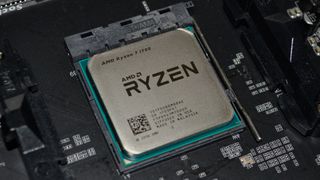The AMD Ryzen 7: plenty of power, but underwhelming gaming performance
Great for video editors, not so great for gamers.

Ryzen gaming performance preview
If you happened to skip straight to this page, please go back and read page three. It's really important. Basically, there are some idiosyncrasies with gaming performance on Ryzen right now, and the results here should be considered somewhat preliminary. This is how Ryzen performance right now in games, using a GTX 1080 FE on the Asus Crosshair VI Hero motherboard at default settings. But tuning a few settings can help quite a bit, and potentially a different motherboard might perform better. I'll be digging into this more next week.
I'm including all of the initial results for the Ryzen processors in the charts, along with a secondary result for the 1800X with SMT disabled. This is, for better or worse, how Ryzen performs in a large collection of games right now. I'm hopeful that some sort of driver or firmware update can improve the situation in the near future, but until/unless that happens, Ryzen gaming performance is a bit of a mixed bag. Several game developers have issued statements of support for Ryzen, saying they're excited for the possibilities that mainstream priced 8-core/16-thread CPUs represent, but it will take time before we see much in the way of Ryzen-specific optimizations.















The i7-6900K leads in average gaming performance by 11 percent compared to the 1800X, but the individual results are the bigger concern. Ashes of the Singularity, Civilization VI, Fallout 4, Far Cry Primal, Hitman, and Total War: Warhammer all have about a 20 percent or higher lead for the 6900K. The 1800X only comes out on top in two games, and not by much: Battlefield 1 (one of the two games AMD showed benchmarks for at the Ryzen event last week), and Shadow Warrior 2, and both leads are relatively small.
But disabling SMT and HPET helps AMD quite a bit in several of the tests. It's not enough to fully close the gap, but Far Cry Primal and Warhammer improve by 16 and 11 percent, respectively, and several other games improve by 5-8 percent. Overall, turning off SMT and HPET improves gaming performance by about five percent on average, with Intel's 6900K and 7700K delivering 6-7 percent higher performance. I suspect that the margin of victory would be larger with a faster GPU like the GTX 1080 Ti, however.
Just to be clear, I don't expect—or want!—gamers to have to enable/disable SMT depending on whether they're gaming or doing video editing, and they shouldn't have to. But if AMD and its partners can fix whatever is going wrong with a driver or firmware update, this becomes a moot point. How hardware got into reviewers' hands before this was addressed is a mystery to me, but let's just hope for a quick recovery.
The 1700X and 1700 are slightly slower, as expected, though I don't have the non-SMT numbers for those chips. They should scale similarly to the 1800X, which means they're still behind the 7600K for now in gaming performance. More interestingly, the gap between even the 1700 and the 1800X is small enough that the 1700 looks particularly compelling, especially if we consider overclocking.
The biggest gaming news, reviews and hardware deals
Keep up to date with the most important stories and the best deals, as picked by the PC Gamer team.
Current page: Ryzen gaming performance preview
Prev Page Ryzen CPU benchmarks Next Page Ryzen overclockingJarred's love of computers dates back to the dark ages when his dad brought home a DOS 2.3 PC and he left his C-64 behind. He eventually built his first custom PC in 1990 with a 286 12MHz, only to discover it was already woefully outdated when Wing Commander was released a few months later. He holds a BS in Computer Science from Brigham Young University and has been working as a tech journalist since 2004, writing for AnandTech, Maximum PC, and PC Gamer. From the first S3 Virge '3D decelerators' to today's GPUs, Jarred keeps up with all the latest graphics trends and is the one to ask about game performance.

AMD's 2025 laptop plans sure do include a lot of refreshed and rebranded APUs, but who cares when you've got Fire Range, Strix Halo, and four RDNA 4 mobile GPUs heading our way next year

Intel admits the Arrow Lake launch missed the mark and promises performance fixes by December, but my testing suggests you shouldn't get your hopes up
Most Popular


